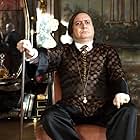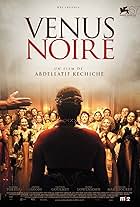It is party day at Marguerite Dumont's castle. She sings wholeheartedly, but terribly out of tune. Marguerite has been living her passion in her own bubble, and the hypocrite audience acts a... Read allIt is party day at Marguerite Dumont's castle. She sings wholeheartedly, but terribly out of tune. Marguerite has been living her passion in her own bubble, and the hypocrite audience acts as if she was the diva she believes she is.It is party day at Marguerite Dumont's castle. She sings wholeheartedly, but terribly out of tune. Marguerite has been living her passion in her own bubble, and the hypocrite audience acts as if she was the diva she believes she is.
- Awards
- 7 wins & 15 nominations
- Director
- Writers
- All cast & crew
- Production, box office & more at IMDbPro
Storyline
Did you know
- TriviaThe name of the title character is a gallicised form of Margaret Dumont, the dignified lady with the figure of an old-time opera singer who was the foil for the Marx Brothers' gags.
- GoofsPlaced in Paris starting from September 1920, and with an almost faithful commitment to the period, except for the sequence when Marguerite, Baronne Dumont sings whilst motion picture images are first projected onto a white sheet and then onto her white clothing. Incorrectly there is the use of a 16mm silent movie film that appears to be projected from a 16mm film projector, however 16mm film was not invented by Eastman Kodak in the USA until 1923. In France in 1922 Pathé Frères invented their 9.5mm silent movie film as part of the Pathé Baby amateur film system, which would have been more likely to be in use in this era.
For the era the incorrect number countdown leader is projected, and any fully trained projectionist would notice the error, and in 1920 we see the 1965 "SMPTE Universal Leader" that was designed and used for television projection applications. Featuring a continuous countdown from eight to two (measured in seconds, rather than feet), with the numbers in the center of a target with two white circles and a rotating "clock arm" animation. "SMPTE Universal Leader" did not gain widespread acceptance theatrically which still used from 1930 "The Academy Leader", and from 1951 "The Society Leader" (both are 16 frames/foot in 35mm film), counting down from eleven to three, and a quick beep is heard at three, with all the numbers appearing upside down. The words 'SIX' and 'NINE' usually appear below their respective numbers.
The Academy leader is specified by SMPTE 301.[1]. The Universal Leader is specified by ANSI/SMPTE 55.
The Society [aka All-Purpose] Leader (1951) is quite complex in design, and is recognizable by its circles with slender arrows pointing to the sides, top, and bottom of each frame (akin to cross-hairs). The numbering is from 11 to 3, but oriented the correct way up, however the SIX and NINE appear as words only. The numbers are again spaced at one foot intervals, i.e. at every sixteenth frame, with 'echoes' of each number in the immediately adjacent frames (so each number actually appears thrice). The Universal [a.k.a. Television] Leader (1965) is the most widely recognized with the familiar 'clocksweep' animated graphic, and the numbering used is from 8 to 2 and with duration of precisely 8secs@24fps. All numbers are the correct way up, and are spaced at 24-frame (1 second) intervals. Since the number 9 has been eliminated, the 6 appears only as a numeral.
- Quotes
Félicité la barbue: [Referring to Marguerite] There are only two ways to deal with life: dream it or live it.
- ConnectionsReferenced in Florence Foster Jenkins (2016)
Naturally, there are two possibilities of Marguerite's apparent oblivion of her own ludicrous voice, a more plausible one is she is fully cognisant of her inadequacy but she is not deterred by it, since she has the wealth to squander, she doesn't mind (or can endure) to be the object of ridicule, as long as it pleases herself and hogs the spotlight due to her self-centred disposition; an alternative possibility could be, she actually doesn't entirely realise how awful her singing capacity is, because, maybe she has some hearing disability or very often, in reality, the recording of one's own voice sounds rather different from what one habitually conceives of, still, the scenario in the case of Marguerite is more serious, in Giannoli's script, she is building castles in the air, what enters in her own ears (while she is singing), assures that she is a qualified coloratura (or mezzo) with distinct talent, an autodidact achieves her faculties by persistent practice. I don't know if there is a medical term for her deep-rooted delusion, or more practically, it is simply Giannoli's creation, which sets to hone the climax, to see what will happen if she hears her real voice from a record player.
In that case, Marguerite is really a wretch despite of her blessed (or cursed) wealth, she is a woman engulfed by lies and pretence, her husband George (Marcon), marries her for the enormous fortune, haunted by guilt, which by the way doesn't stop him from conducting an extramarital affair, and has no guts or whatsoever to rescue her from the elephant-in-the-room; others regard her as a laughing stock, either egg her on or refrain from candour for their own sake, including the opportunistic young reporter Lucien (Dieuaide) and his poet friend Kyrill (Fenoy), who merely exploits her as an anomaly for his own anarchic propaganda.
It is riveting to watch Catherine Frot feigns her impassioned performance under the salvo of off- key ululation, which is carefully meted out to aptly eke out laughter in each of the film's five chapters. Besides, Ms. Frot doesn't yield to the simplified caricature of Marguerite, in lieu, her self- possessed mannerism glistens with bons mots, she balances off Marguerite's larger-than-life image with endearing subtlety which reflects her as a sensible human being, she is, after all, a woman dares to be honest with her own passion and feelings, against all odds. Comedian Michel Fau is pre-eminent in his flamboyant turn as Marguerite's singing coach Atos Pezzini, a gay opera singer, who is blackmailed into accepting this impossible task by Marguerite's loyal butler Madelbos (Mpunga), who, undoubtedly, is the most inscrutable player in Marguerite's enterprise, with his own agenda which is applied as a game-changer in the end but rings hollow in its own seriousness.
Shot entirely in Czech Republic, as a fill-in for Paris, the film adopts a more subdued palette of the roaring 20s, albeit of its amazingly detailed vintage decor, as if Giannoli tries to forewarn us of the finale throughout the whole journey, MARGUERITE is not a farce of titbits, she is a by-product comes to fruition in a hypocritical society, you can mock her, but she actually accomplish something few of us dare to even start with.
- lasttimeisaw
- Jun 13, 2016
- Permalink
- How long is Marguerite?Powered by Alexa
Details
- Release date
- Countries of origin
- Official sites
- Languages
- Also known as
- Madame Marguerite
- Filming locations
- Production companies
- See more company credits at IMDbPro
Box office
- Budget
- €8,000,000 (estimated)
- Gross US & Canada
- $506,677
- Opening weekend US & Canada
- $19,924
- Mar 13, 2016
- Gross worldwide
- $8,754,356
- Runtime2 hours 9 minutes
- Color
- Aspect ratio
- 2.35 : 1
Contribute to this page
































